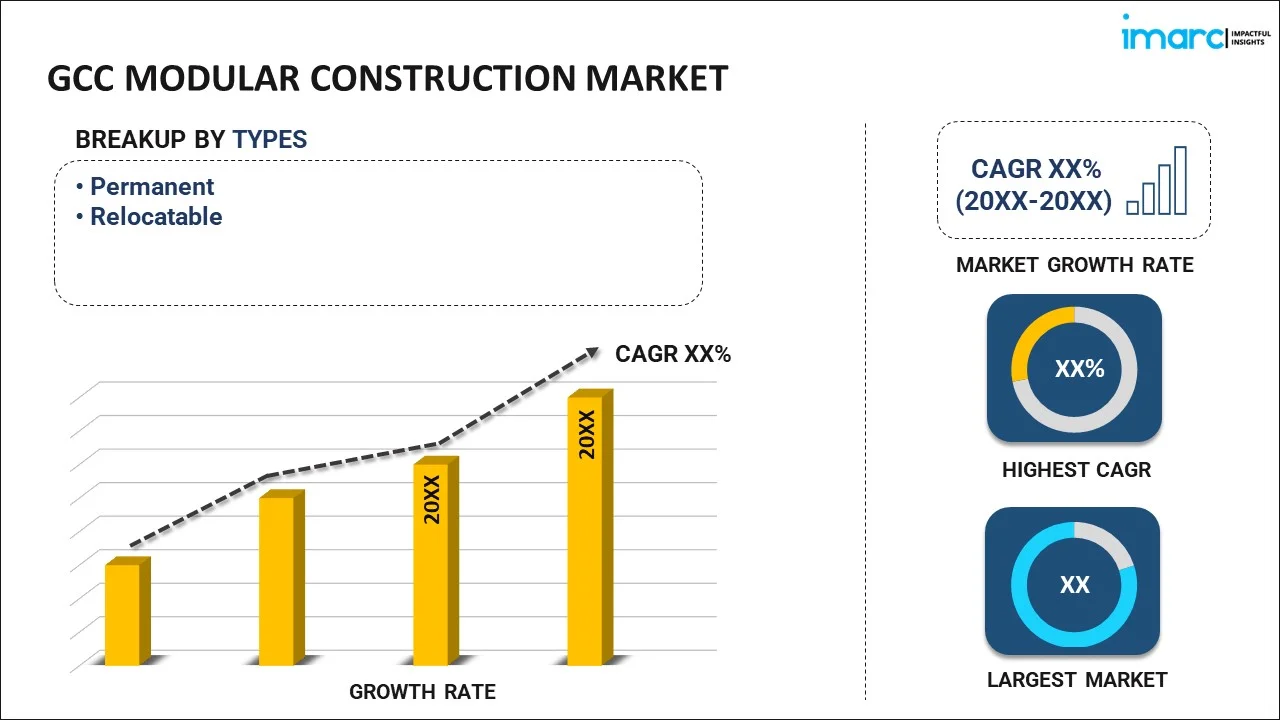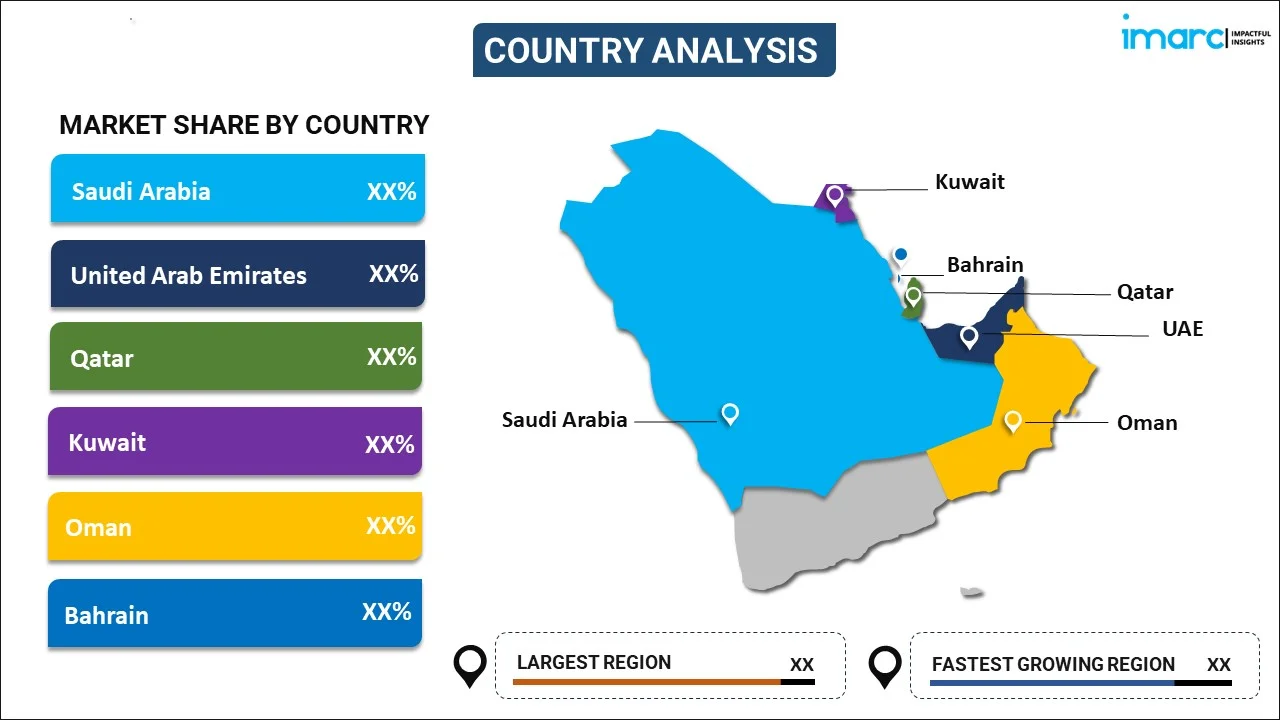
GCC Modular Construction Market Report by Type (Permanent, Relocatable), Module Type (Four Sided, Open Sided, Partially Open Sided, Mixed Modules and Floor Cassettes, Modules Supported by a Primary Structure, and Others), Material (Steel, Concrete, Wood, Plastic, and Others), End Use (Residential, Commercial, Education, Retail, Hospitality, Healthcare, and Others), and Country 2025-2033
Market Overview:
GCC modular construction market size reached USD 2.0 Billion in 2024. Looking forward, IMARC Group expects the market to reach USD 3.3 Billion by 2033, exhibiting a growth rate (CAGR) of 5.7% during 2025-2033. The rising need for buildings that can withstand extreme weather conditions and offer enhanced durability, along with the growing focus of key industry players on reducing project timelines, is primarily augmenting the market growth across the region.
|
Report Attribute
|
Key Statistics
|
|---|---|
|
Base Year
|
2024
|
|
Forecast Years
|
2025-2033
|
|
Historical Years
|
2019-2024
|
|
Market Size in 2024
|
USD 2.0 Billion |
|
Market Forecast in 2033
|
USD 3.3 Billion |
| Market Growth Rate 2025-2033 | 5.7% |
Modular construction is an approach wherein a building or structure is assembled away from the construction site, employing identical materials and following the same standards as traditional on-site construction but within a controlled factory setting. This method includes the creation of individual elements referred to as modules, which are then brought to the site for assembly, culminating in the finished structure. The modules are produced with meticulous precision and efficiency, guaranteeing uniform quality and compliance with distinct design criteria. This method is distinguished by its design flexibility, the controlled manufacturing environment, the prospect of heightened sustainability, etc.
GCC Modular Construction Market Trends:
The GCC modular construction market is witnessing significant growth driven by various drivers and trends that underscore the region's commitment to innovative and efficient building practices. One key driver is the inflating need for scalable construction solutions, particularly in countries like Saudi Arabia and the UAE, where infrastructure projects are increasing. Moreover, technological advancements, including the rising integration of Building Information Modeling (BIM) and advanced manufacturing techniques, are also positively influencing the regional market. Besides this, continuous innovations enhance the precision and customization of modular components, ensuring a seamless fit during on-site assembly, which is acting as another significant growth-inducing factor. Additionally, the real estate industry is experiencing a surge in demand for sustainable construction practices to support environmental sustainability, minimize material waste, optimize energy efficiency, etc. Apart from this, key players are often incorporating eco-friendly materials, thereby catalyzing the regional market. Furthermore, flexibility in design is another prominent trend, allowing for creative and customized solutions to meet diverse project requirements. In line with this, the modular approach accommodates various architectural styles and functions, providing a versatile option for different construction needs. Additionally, the inflating need for efficient, sustainable, and innovative building practices is expected to fuel the market growth across the GCC over the forecasted period.
GCC Modular Construction Market Segmentation:
IMARC Group provides an analysis of the key trends in each segment of the market, along with forecasts at the regional and country levels for 2025-2033. Our report has categorized the market based on type, module type, material, and end use.
Type Insights:

- Permanent
- Relocatable
The report has provided a detailed breakup and analysis of the market based on the type. This includes permanent and relocatable.
Module Type Insights:
- Four Sided
- Open Sided
- Partially Open Sided
- Mixed Modules and Floor Cassettes
- Modules Supported by a Primary Structure
- Others
A detailed breakup and analysis of the market based on the module type have also been provided in the report. This includes four sided, open sided, partially open sided, mixed modules and floor cassettes, modules supported by a primary structure, and others.
Material Insights:
- Steel
- Concrete
- Wood
- Plastic
- Others
The report has provided a detailed breakup and analysis of the market based on the material. This includes steel, concrete, wood, plastic, and others.
End Use Insights:
- Residential
- Commercial
- Education
- Retail
- Hospitality
- Healthcare
- Others
A detailed breakup and analysis of the market based on the end use have also been provided in the report. This includes residential, commercial, education, retail, hospitality, healthcare, and others.
Country Insights:

- Saudi Arabia
- United Arab Emirates
- Qatar
- Kuwait
- Oman
- Bahrain
The report has also provided a comprehensive analysis of all the major regional markets, which include Saudi Arabia, United Arab Emirates, Qatar, Kuwait, Oman, and Bahrain.
Competitive Landscape:
The market research report has also provided a comprehensive analysis of the competitive landscape in the market. Competitive analysis such as market structure, key player positioning, top winning strategies, competitive dashboard, and company evaluation quadrant has been covered in the report. Also, detailed profiles of all major companies have been provided.
GCC Modular Construction Market Report Coverage:
| Report Features | Details |
|---|---|
| Base Year of the Analysis | 2024 |
| Historical Period | 2019-2024 |
| Forecast Period | 2025-2033 |
| Units | Billion USD |
| Scope of the Report | Exploration of Historical Trends and Market Outlook, Industry Catalysts and Challenges, Segment-Wise Historical and Future Market Assessment:
|
| Types Covered | Permanent, Relocatable |
| Module Types Covered | Four Sided, Open Sided, Partially Open Sided, Mixed Modules and Floor Cassettes, Modules Supported by a Primary Structure, Others |
| Materials Covered | Steel, Concrete, Wood, Plastic, Others |
| End Uses Covered | Residential, Commercial, Education, Retail, Hospitality, Healthcare, Others |
| Countries Covered | Saudi Arabia, United Arab Emirates, Qatar, Kuwait, Oman, Bahrain |
| Customization Scope | 10% Free Customization |
| Post-Sale Analyst Support | 10-12 Weeks |
| Delivery Format | PDF and Excel through Email (We can also provide the editable version of the report in PPT/Word format on special request) |
Key Questions Answered in This Report:
- How has the GCC modular construction market performed so far and how will it perform in the coming years?
- What has the impact of COVID-19 on the GCC modular construction market?
- What is the breakup of the GCC modular construction market on the basis of type?
- What is the breakup of the GCC modular construction market on the basis of module type?
- What is the breakup of the GCC modular construction market on the basis of material?
- What is the breakup of the GCC modular construction market on the basis of end use?
- What are the various stages in the value chain of the GCC modular construction market?
- What are the key driving factors and challenges in GCC modular construction?
- What is the structure of the GCC modular construction market and who are the key players?
- What is the degree of competition in the GCC modular construction market?
Key Benefits for Stakeholders:
- IMARC’s industry report offers a comprehensive quantitative analysis of various market segments, historical and current market trends, market forecasts, and dynamics of the GCC modular construction market from 2019-2033.
- The research report provides the latest information on the market drivers, challenges, and opportunities in the GCC modular construction market.
- Porter's five forces analysis assist stakeholders in assessing the impact of new entrants, competitive rivalry, supplier power, buyer power, and the threat of substitution. It helps stakeholders to analyze the level of competition within the GCC modular construction industry and its attractiveness.
- Competitive landscape allows stakeholders to understand their competitive environment and provides an insight into the current positions of key players in the market.
Need more help?
- Speak to our experienced analysts for insights on the current market scenarios.
- Include additional segments and countries to customize the report as per your requirement.
- Gain an unparalleled competitive advantage in your domain by understanding how to utilize the report and positively impacting your operations and revenue.
- For further assistance, please connect with our analysts.
 Inquire Before Buying
Inquire Before Buying
 Speak to an Analyst
Speak to an Analyst
 Request Brochure
Request Brochure
 Request Customization
Request Customization




.webp)




.webp)












